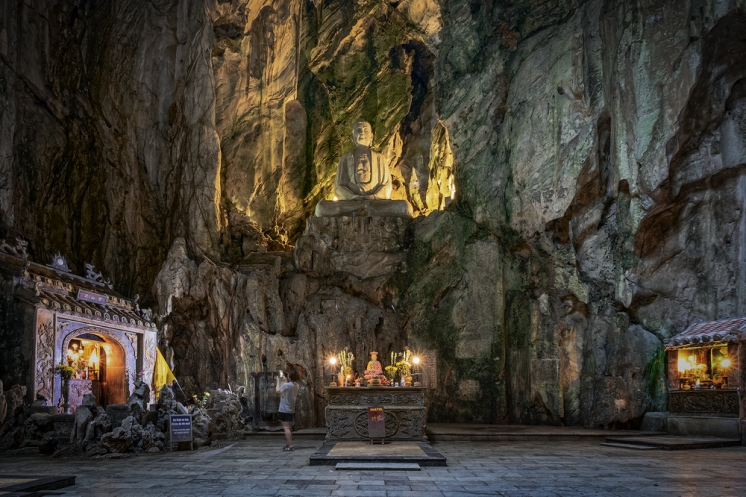Ngu Han Son – Marble Mountains and Stone Sculpture Village – Part 2

Thuy Son – Water Mountain
It doesn’t probably make sense to analyse the particular hills, their shrines and cave systems in detail. Let’s focus on the most interesting and highest of them, which is Thuy Son – Water Mountain.
It is interesting in several points:
- One of the oldest traditional stone villages in Da Nang is the entrance gate to the bowels of the mountain.
- Cave of Heavenly Light – Huyen Khong.
- Buddhist and Hindu shrines.
- The stone sculpture village of Non Nuoc
The village of Non Nuoc is, as already mentioned, one of the oldest stone sculpture villages in the area, where stone exploited in the area has been traditionally mined and handcrafted for 400 years. At present, however, this is no longer entirely true, because since the declaration of the whole area as a protected area, mining in the quarries of five hills has ceased and the material is imported from other areas of Vietnam. However, traditional sculptural production has never been interrupted, on the contrary, since 2009 it has become part of the so-called National Intangible Cultural Heritage. The village was founded by the stonemason Huynh Ba Quant.
Pagoda and temple caves
Following the steep staircase with 156 steps from 1630, partially carved into the mountain, we get under the top of the Water Mountain to the 400-year-old Tam Thai pagoda dedicated to Phat Di Lac. In the past, the pagoda was designed to worship both Hindu and Buddhist deities. It is currently intended for the worship of the Cham gods.
From this place it is possible to visit several cave shrines. The most interesting is the large temple cave of Huyen Khong – Heavenly Light as well as a small narrow cave of Van Thong, through which, along a narrow creep path, it is possible to reach the top of the Water Mountain offering an unforgettable view of the whole scenery of Ngu Hanh Son, i.e. Marble Mountains.
We reach the Cave of Heavenly Light – Huyen Khong along the path under the top of the mountain and through the ancient entrance stone gate to the foyer of the cave with a statue of one of the parables of the Buddha with a small altar. Further on through the darkness to the staircase to the main hall of Huyen Khong Cave, which is imbued with a strange moving light coming from natural holes in the collapsing ceiling. The individual rays slowly glide over the majestic sacral decoration of the sanctuary, and it really makes a special, unforgettable impression on a visitor.
Before descending the stairs down to the shrine, everyone is attracted by a giant Buddha sculpture on the opposite wall of the cave, carved directly into the rock. It looks really monumental, but compared to the other decorations it is very young, created by stonemasons from the nearby village of Non Nuoc in 1960.
After descending to the bottom of the cave, rays of light from the holes in the ceiling illuminate three main places in the space. To the left of the Buddha statue there is an ancient shrine divided into three parts. The main part – the middle one – is dedicated to the Bodhisattva that appears and miraculously helps whenever you are in danger. On the other side, the altar is designed to worship the three goddesses that symbolize wisdom, morality and loyalty. The statue to worship the goddess that brings blessings to couples is another place.

Mountains as stone witnesses
This whole area of the five peaks of the Marble Mountains has undergone many changes, falls and rebirths in human history. It has witnessed a turbulent history from prehistoric times through medieval skirmishes to the modern history of French colonization and the Vietnam-American War. But this place has always brought its inhabitants refuge and protection in bad times and well-being and inner peace in good times. Everything is stored and recorded in the memory of these five mountains.
Source: www.lomyatezba.cz
